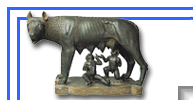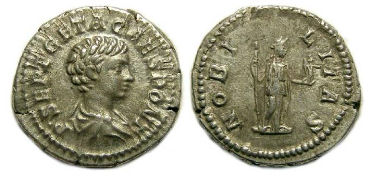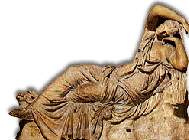 |
 |
ANCIENT ROMAN COINS - Imperial
|
|||||||||||||
|
(Reference: S=Sear Roman Coins and Their Values (2000 edtion), RSC=Roman Silver Coins, RIC=Roman Imperial Coinage, MILNE=Catalogue of Alexandrian coins; GIC=Greek Imperial Coinage by Seaby) |
|
 Geta, AD 209 to 212. AE 27
from Rabbathmoba in Arabia. - SCARCE TYPE. Denomination: AE 27 Mint: Rabbathmoba Arabia. Reference: SNG ANS 6 #1418. Size: 26.7 x 27.9 mm. Weight: 13.79 grams. Grade: Fine with a dark brown patination. This is a fairly nice example for the type, which is seldom seen in high quality. Obverse: Head of Geta right, with POV CEP G visible to the left, which confirms the attribution to Geta, but the inscription to the right did not strike up. The part on the right would probably have been ETA KAI . Reverse: War god standing forward between two torches, holding sword and shield, with RABAQ MUBA around (but only fragments of the inscription are visible) $245.00 |
 Orbiana, AD 225 to 227. AR denarius.
Denomination: Silver denarius. Mint: Rome. Date: AD 225. Size: 17.9 x 20.4 mm. Weight: 2.77 grams. Reference: Sear-8191, RSC-1, Grade: VF but somewhat rough. Obverse: Head of Orbiana right, with SALL BARBIA ORBIANA AVG around. Reverse: Concordia seated left, holding a patera and double cornucopiae, with CONCORDIA AVGG around. SOLD |
 Geta, AD 198 to 209. Silver denarius
Denomination: Silver denarius.Mint: Rome. Date: issued of AD 199. Size: 18.6 x 19.8 mm. Weight: 3.47 grams. Reference: Sear-7184 Grade: gVF Obverse: Head of Geta right, with P SEPT GETA CAES PONT around. Reverse: Nobilitas standing right, holding a sceptre and palladium, with NOBILATAS around. SOLD |
 Julia Mamaea, Copper As, AD 222 to 235.
Denomination: Silver denarius. Mint: Rome. Date: issue of AD 228. Reference: Sear-8243 Size: 24.1 x 25.0 mm. Weight: 11.60 grams. Grade: gVF with a mid brown patination, and just a trace of roughness. Obverse: Head of Julia Mamaea right, with IVLIA MAMAEA AVGVSTA around. Reverse: Felicitas standing left, leaning back on a column, holding a caduceus, flanked by S C, with FELICITAS PVBLICA around. SOLD |
|
(Reference: S=Sear Roman Coins and Their Values (2000 edtion), RSC=Roman Silver Coins, RIC=Roman Imperial Coinage, MILNE=Catalogue of Alexandrian coins; GIC=Greek Imperial Coinage by Seaby) |
|
ALL PRICES ARE IN US DOLLARS
CANADIAN ORDERS MUST ADD GST/HST TO ALL PRICES
FOR ADDITIONAL ANCIENT COINS WE HAVE AVAILABLE
PLEASE SEE OUR VCOINS STORE
www.vcoins.com/calgarycoinNext page of Roman Coins
Top of Page


AD 194, THE YEAR OF "EMPIRE FOR SALE"The assassination of Commodus, in AD 192, left the Empire with no heir apparent. In what may have been an attempt to maintain control from behind the scenes, the assassins convinced the senator Pertinax to accept the throne. By this time the Praetorian Guard wielded much power and had to be paid 12,000 sestertii each to accept Pertinax as Emperor. Pertinax's intentions appear to have been good, but he tried to reform too much, too fast. In an attempt to stop corruption within the palace, he alienated the Praetorians who turned on him and beat him to death after a reign of only 87 days. With no obvious successor, and with a taste for the money they were paid by Pertinax, the Praetorians decided to auction the position of Emperor. At a bid of 25,000 sestertii per Praetorian, the unlucky buyer was Didius Julianus. The opening left by the death of Pertinax also attracted two other candidates, Pescennius Niger (governor of Syria) and Septimius Severus (governor of Upper Pannonia). Pescennius Niger may have had the upper hand, but was delayed in Antioch. Septimius Severus, after giving Clodius Albinus the rank of Caesar (with instructions to control the West), immediately marched on Rome. With his power stemming solely from the Praetorians, Didius Julianus had no chance against the approaching army of Severus. The Praetorians deserted him and the Senate ordered him killed, thus ending a reign of only 66 days. With Rome under his control, Severus turned his attention to Pescennius Niger whom he defeated after several battles. While Severus was preoccupied in the east with Niger, Clodius Albinus turned against him by declaring himself Augustus. PESCENNIUS NIGER, AD 193-194The denarii of Pescennius Niger are normally struck on relatively base silver and will have slightly rough surfaces. Examples of good smooth metal are scarce. The weights of these base denarii vary greatly, and I have seen examples as low as 1.6 grams, and as high as 3.6 grams (they seem to average about 2.4 grams). Until recently all coins of Niger were considered rare, but in the past decade Niger denarii have been showing up in significant numbers from Balkan hoards, and prices are now significantly lower than they once were. When the Balkan hoards come to an end, Niger's coinage will probably again become much more difficult to find. THE SEVERAN DYNASTYWith Pescennius Niger out of the way, Septimius Severus turned his attention on his old ally, Clodius Albinus. It took two years, but Clodius Albinus was eventually defeated in AD 197, leaving Septimius Severus as sole Emperor of Rome. Severus then turned his attention to setting up an infrastructure from within his own family. He gave the rank of Caesar to his two sons, Caracalla and Geta, thus starting the Severan Dynasty which would last until the murder of Severus Alexander in AD 235. As with most of Roman history, these were very violent times. Only Septimius Severus died a natural death. All of his descendants met violent ends, often at early ages and sometimes at the hands of their own relatives. In the case of Geta, he was murdered by Caracalla, his own brother. From the point of view of a coin collector, this is an interesting period to collect. The portrait coins of Septimius Severus and his blood relatives are readily available and generally inexpensive in nice condition. Special attention should be paid to the coinage of the women of the Severan Dynasty. While wives and mothers of the emperors wielded considerable influence throughout the Roman empire, it seems to have been especially true at this time. SEPTIMIUS SEVERUS, AD 193-211Many of Septimius Severus' issues can be directly related to the historical events of his reign, and where possible we have chosen to present them within those contexts, which I hope will help you understand more about these issues. Civil War with Niger, AD 194-196This type was struck in late AD 196 or early AD 197 and records the entry of Severus into Rome as he returned from his Victory over Niger. Although, Niger had been defeated more than a year earlier, Severus spend that year in the east stabilizing things in the east and did not return to Rome right away. Civil War with Clodius Albinus, AD 196-197In AD 196-197, Septimius Severus was at war with Clodius Albinus in the West. This type appears to have been struck to invoke Hercules' to help with the defense of the Empire against Albinus. Imperial visit to Africa, AD 207This type was struck in AD 207 to commemorate an Imperial visit to Severus' home province of Africa that year. During this trip he gave honors to the Punic god of healing (equivalent to the Roman Aesculapius), so it seems very likely that Severus was suffering some illness at the time. CLODIUS ALBINUS, AD 193-197We list Clodius Albinus under the Severan Dynasty, right after Septimius Severus, because his first issues of coins were struck for him as Caesar under Septimius Severus in AD 193-195, which made him temporarily part of the Severan dynasty. ELAGABALUS, AD 218-222Elagabalus' given name was Varius Avitus Bassianus but he later became known as M. Aurelius Antoninus, which is the name used on his coinage. He was the great-grand nephew of Septimius Severus and Julia Domna through Julia Soaemias and Julia Maesa. At an early age he became priest of the sun-god Elagabalus, hence the name by which we know him. His rule was one of great cruelty and in AD 222, he and his mother were murdered in the praetorian camp. JULIA MAESA, AD 218-226Julia Maesa was the sister of Julia Domna, mother of Julia Soaemias and Julia Mamaea, and Grandmother of both Elagabalus and Severus Alexander. She is thought to be largely responsible for the revolt against Macrinus that restored the power of the Severan Dynasty and brought Elagabalus to the throne. Most of her coins were struck under Elagabalus, although she lived for three years after Severus Alexander took the throne, and he struck commemoratives for her after her death. SEVERUS ALEXANDER, AD 222-235Severus Alexander was the son of Julia Mamaea. At the age of 13 (AD 221) he was adopted by Elagabalus and succeeded him to the throne in AD 222. Largely dominated by his mother, who probably held much power over him, the first nine years of his reign was a period of peace and prosperity for the Empire. Then, in AD 230, the peace ended as the Sassanid Empire in the east looked toward annexing Mesopotamia, Syria and Cappadocia. Severus traveled east in AD 231 and campaigned successfully against the Sassanids and returned to Rome in AD 233. Almost immediately he had to travel north to deal with a German invasion, and while he had some initial success, the troops were unhappy with him and his mother, and in March of AD 235 they were murdered by troops loyal to Maximinus, thus ending the Severan Dynasty. JULIA MAMAEA, AD 222-235Julia Mamaea was the daughter of Julia Soaemias and mother of Severus Alexander. She was probably the real power behind the throne, using Alexander as a figurehead Emperor, and must have even traveled with him on military campaigns. She was unpopular with the army and as she was murdered with him at a camp near Mainz in Germany on March 22nd, AD 235. |
| Top of Page Copyright © 1997-2005 R & T Enterprises Ltd. |
 |